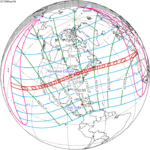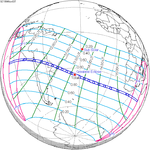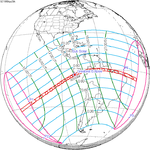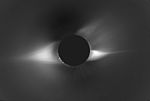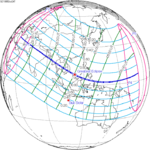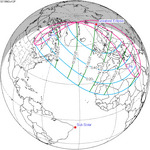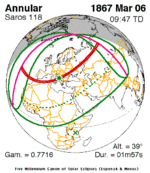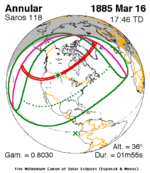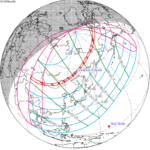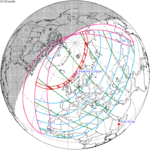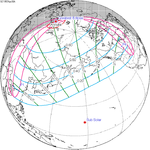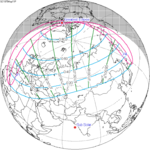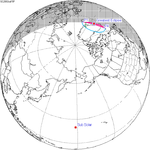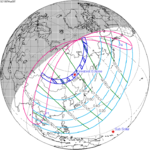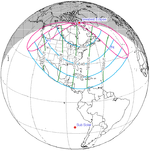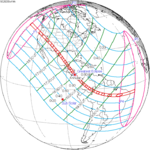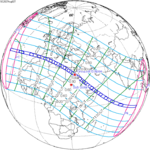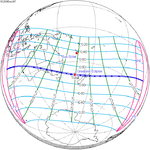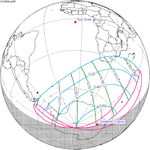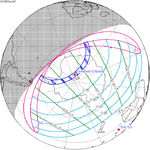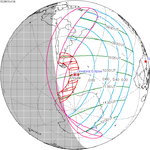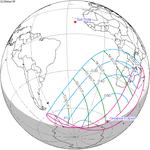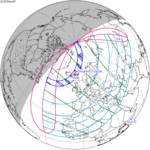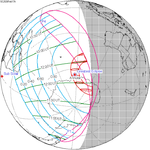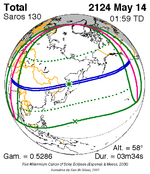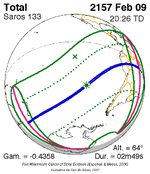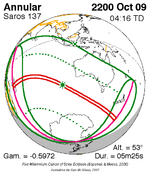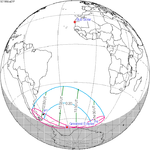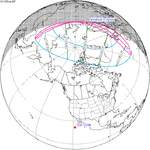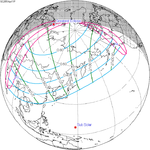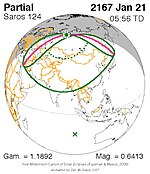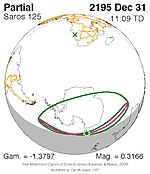|
Solar eclipse of May 21, 1993
A partial solar eclipse occurred at the Moon's descending node of orbit on Friday, May 21, 1993,[1] with a magnitude of 0.7352. A solar eclipse occurs when the Moon passes between Earth and the Sun, thereby totally or partly obscuring the image of the Sun for a viewer on Earth. A partial solar eclipse occurs in the polar regions of the Earth when the center of the Moon's shadow misses the Earth. A partial eclipse was visible for parts of Alaska, Canada, Greenland, the United States, and Northern Europe. ImagesEclipse detailsShown below are two tables displaying details about this particular solar eclipse. The first table outlines times at which the moon's penumbra or umbra attains the specific parameter, and the second table describes various other parameters pertaining to this eclipse.[2]
Eclipse seasonThis eclipse is part of an eclipse season, a period, roughly every six months, when eclipses occur. Only two (or occasionally three) eclipse seasons occur each year, and each season lasts about 35 days and repeats just short of six months (173 days) later; thus two full eclipse seasons always occur each year. Either two or three eclipses happen each eclipse season. In the sequence below, each eclipse is separated by a fortnight.
Related eclipsesEclipses in 1993
Metonic
Tzolkinex
Half-Saros
Tritos
Solar Saros 118
Inex
Triad
Solar eclipses of 1993–1996This eclipse is a member of a semester series. An eclipse in a semester series of solar eclipses repeats approximately every 177 days and 4 hours (a semester) at alternating nodes of the Moon's orbit.[3]
Saros 118This eclipse is a part of Saros series 118, repeating every 18 years, 11 days, and containing 72 events. The series started with a partial solar eclipse on May 24, 803 AD. It contains total eclipses from August 19, 947 AD through October 25, 1650; hybrid eclipses on November 4, 1668 and November 15, 1686; and annular eclipses from November 27, 1704 through April 30, 1957. The series ends at member 72 as a partial eclipse on July 15, 2083. Its eclipses are tabulated in three columns; every third eclipse in the same column is one exeligmos apart, so they all cast shadows over approximately the same parts of the Earth. The longest duration of totality was produced by member 34 at 6 minutes, 59 seconds on May 16, 1398, and the longest duration of annularity was produced by member 59 at 1 minutes, 58 seconds on February 23, 1849. All eclipses in this series occur at the Moon’s descending node of orbit.[4]
Metonic seriesThe metonic series repeats eclipses every 19 years (6939.69 days), lasting about 5 cycles. Eclipses occur in nearly the same calendar date. In addition, the octon subseries repeats 1/5 of that or every 3.8 years (1387.94 days). All eclipses in this table occur at the Moon's descending node.
Tritos seriesThis eclipse is a part of a tritos cycle, repeating at alternating nodes every 135 synodic months (≈ 3986.63 days, or 11 years minus 1 month). Their appearance and longitude are irregular due to a lack of synchronization with the anomalistic month (period of perigee), but groupings of 3 tritos cycles (≈ 33 years minus 3 months) come close (≈ 434.044 anomalistic months), so eclipses are similar in these groupings. The partial solar eclipses on March 27, 1884 (part of Saros 108) and December 24, 1916 (part of Saros 111) are also a part of this series but are not included in the table below.
Inex seriesThis eclipse is a part of the long period inex cycle, repeating at alternating nodes, every 358 synodic months (≈ 10,571.95 days, or 29 years minus 20 days). Their appearance and longitude are irregular due to a lack of synchronization with the anomalistic month (period of perigee). However, groupings of 3 inex cycles (≈ 87 years minus 2 months) comes close (≈ 1,151.02 anomalistic months), so eclipses are similar in these groupings.
References
External links
|
||||||||||||||||||||||||||||||||||||||||||||||||||||||||||||||||||||||||||||||||||||||||||||||||||||||||||||||||||||||||||||||||||||||||||||||||||||||||||||||||||||||||||||||||||||||||||||||||||||||||||||||||||||||||||||||||||||||||||||||||||||||







